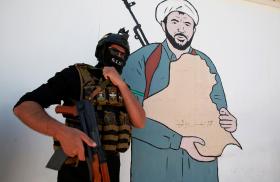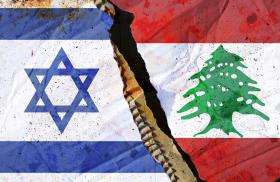This presentation will expound on security and coexistence, an alternative approach to breaking the deadlock between Israel and the Palestinians. But first, a discussion of the strategic conflict is needed. This conflict stems from the strength and development in the Middle East, coupled with the existence of hostility and hatred. Fifty years after the creation of Israel, hostility, hatred, and suspicion still characterize the political landscape of the Middle East.
On the most basic level, Palestinians and Arabs still have not fully accepted the legitimacy of a non-Arab, non-Muslim entity in the region like the State of Israel. The question is, must Israel wait for this attitude to change? I believe not. The relentless effort to achieve peace should remain a guiding principle in all considerations.
Israel is a small country. Its size is 24,000 square kilometers including the Golan Heights—less than 10,000 square miles—the size of the state of New Jersey. Everything is on a small scale. The distance from the Jordan River, Israel’s eastern border, to Tel Aviv on the coastline, is 70 kilometers, or 44 miles; to Haifa, 60 kilometers, or 37 miles; to Jerusalem, 30 kilometers, or 19 miles.
At the current time, there is an unprecedented arms race, both conventional and nonconventional, underway in the Middle East. Israel is a country that absorbed mass immigration and thus has to meet social, economic, and humanitarian needs on a large scale. It cannot, and does not want to, compete in this race. In addition, the threat of weapons of mass destruction emanating from such countries as Iran and Iraq makes territory and strategic depth vital for security in general and for Israel in particular. No state has ever given up central strategic depth or territory. Moreover, Israel is dealing with a small territory and minimum strategic depth.
I know it seems like bazaar-bargaining in the negotiations for further redeployments, talking about one percent here, about another percent there. Yet each one of those percentages describes a territory. There is something behind the numbers.
It’s very nice to speak about overall peace, and all Israelis would like to have peace. Yet, the government cannot separate it from the current situation, from the arms race in the Middle East. Syria, with annual consumption per capita that is $1,100 less than in Gaza, possesses 5,000 tanks and around 1,000 surface-to-surface missiles, and perhaps one of the largest arsenals of chemical weapons in the world. Egypt is also building its arsenal. Israel has peaceful relations with Egypt, and I was a great supporter of this peace. Yet Egypt is building the largest military strength in the Middle East. Just a few months ago, Israel was facing a threat from Iraq. With all these potential threats, could Israel just give up vital land or its early-warning stations? The answer is no.
Water is another major problem in the Middle East. It’s a question of life and death. Labor party members have attacked me on this issue; I believe that the Palestinians are entitled to have the same quantity of water as ourselves. But are we, at the present time, ready to give them control of the source of that water, which serves us as well? The answer is no.
Israel has vital security and water issues that require land. Israel cannot now give up 2 percent, or 2.5 percent. But Israel is eager to reach peace.
The arms race, early-warning stations, and water are tactical issues. Terrorism in the Middle East is a strategic threat, not just a tactical problem. Terrorist activity has preceded and instigated almost all wars in the region. Cold-blooded terrorism against Israel served as a catalyst in the past for Soviet penetration in the Middle East. Without a concerted struggle against terrorism, peace efforts and peace itself will continue to be held as hostages of terror and its instigators.
The real tragedy of the conflict is the refugee problem. About one million Palestinians left Israel during the War of Independence, mainly after being encouraged to do so by the invading Arab countries. At the same time, Israel absorbed about one million Jews from various Arab and Muslim countries, Jews who had fled and left their property behind. Although the flight of the Palestinian refugees in 1948 took a few months—or maybe a few weeks—while that of the Jews, from Arab countries, took several years, the figures are almost the same.
The solution must be to keep the 1948 refugees in the places where they live today through a joint Arab-Israeli international program financed by other states. As for the 1967 refugees, the possibility of their resettlement and return should be considered. And for the rest, a fair solution would be mutual compensation both for Palestinians and for Jews from Arab countries.
There are two competing trends in the Middle East for future development: one, a gradual development of understanding and concern regarding economic development, modernization, and openness to the West; and two, increased radical Islamic fundamentalism in its various manifestations.
There is an ongoing conflict between these two trends in many countries in the Middle East. If the first trend prevails, it will be a very significant development in the region toward the establishment of durable peace. It is going to be a prolonged process, however, and meanwhile, immediate risks and dangers still exist.
Israel is forging peace agreements in the region. There is a cold but very important peace agreement with Egypt. Israel has a developing peace with Jordan, of which I am content to be a partner and a contributor to its development. With the Palestinians, the present government has accepted the Oslo Accords, despite the inherent complexities and risks. I personally, with the whole government of Israel, want to reach a peace agreement with the Palestinians. I believe it to be possible and necessary. There is a question as to whether Israel and the Palestinians can reach this peace agreement according to the Oslo timetable. I have some doubt about that.
The Oslo agreement is very important for the Palestinians, as it is the only official agreed-upon document they have. The Jews have another document, a much older one—the Bible. But Israel understands the importance of the Oslo agreement to the Palestinians, as it is the only agreement they possess.
For Israel, the time dimension that will allow for the development of normalized relations of coexistence is most important. The Palestinians, suspecting that Israel does not intend to implement the agreement, are interested in exerting pressure on Israel. It should be emphasized that any pressure that will increase the security threat to Israel is totally unacceptable.
Although the Palestinian Authority already controls 98 percent of the Palestinian population in Judea and Samaria, the main complaint is that the areas under their control are like swiss cheese, lacking contiguity, while security checks and roadblocks cause hardship to the civilian population. The reason for this is not because Israel would like to make their life harder; rather, the reason is security. But Israelis understand that the lack of territorial contiguity is a problem.
To reiterate, 98 percent of the Palestinian population, at the present time, is governed by the Palestinian Authority. Thus, one cannot speak about the Palestinians being occupied.
Israel insists on reciprocity. Both sides must honor and fulfill their commitments. Unfortunately, in many cases, the Palestinians have not followed this principle and have not fulfilled their commitments. The Palestinian covenant, calling for the destruction of Israel, which has to be voted on by the Palestinian National Council, has not been changed. The reduction of the size of the Palestinian armed forces to its agreed-upon size has also not been fulfilled. The Hebron agreement, which the Palestinians signed, is yet to be implemented. Moreover, the Palestinian Authority is not conducting a true, full-scale struggle against the terror infrastructure in the areas under its control, as it committed itself to do in the agreement. No steps have been taken against the infrastructure of the Hamas terrorist organization.
Judea and Samaria are the historical and cultural roots of the Jewish people. One must always remember that Judea and Samaria, the so-called “occupied territories,” are the cradle of the Jewish people. There has been an uninterrupted Jewish life and presence in Israel for thousands of years, and no nation on earth would give up territory and historical sites that are the roots of its national existence—the Cave of the Patriarchs, Rachel’s Tomb, and Shiloh, to mention a few. Yet, Israel has decided that it is willing to compromise and make concessions in order to reach peace.
How can the process be advanced? The following is my position and my proposal for moving forward and avoiding crises in the future. Please recognize that I am not presenting the position of the government.
First, there must be crisis-avoidance in the course of the negotiations. The greatest effort must be exerted to prevent crises, which may cause a breakdown of the entire process. Israel must try to do whatever is possible to ease and improve the daily condition of Palestinians in the territories. Yet, Israel must also protect and insist on maintaining its basic strategic requirements for its security and existence, which must include security zones. Most important, Israel’s position must be stated in clear terms. In principle, two parallel tracks to advance the peace process must be pursued. A political-strategic track—including border, security, territorial, and reciprocal agreements—coupled with a humanitarian-economic track, which would improve economic conditions and offer humanitarian incentives and mutual confidence-building measures.
The process can be divided into two phases: The first phase will provide for Palestinian contiguity. Israel should allow free passage and travel within a defined period of time in territories under PA control and continue full PA administration over part of the territories and full control over 98 percent of the population. The security zones will remain in Israel’s hands and under full Israeli security control. The second phase entails a development of security, economic, and civilian cooperation to enhance trust and confidence for mutual peaceful coexistence. The greater the cooperation, the easier the path to a permanent agreement.
It is possible to reach an agreement with the Palestinians in the interim phase, which would be somewhat similar to the concept of nonbelligerency. This will provide Palestinians with the possibility of keeping and holding to the Oslo Accords, and for Israel, the necessary time to examine and see if the conditions for a true and lasting peace have materialized.
Finally, the concepts presented here, this alternative approach of crisis-avoidance and the concept of less than a full peace agreement, should be considered as a fall-back position. If, at a certain point, it becomes clear to all parties that the current efforts to reach an agreement have failed, then it would be in the interest of both Israel and the Palestinians to adopt this approach as a means of breaking the deadlock and reviving the peace process.
Ahmed Qurei addressed the conference on this same topic. Read his remarks.

